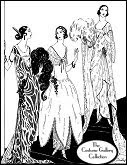
It is hard to believe today that nearly 100 years ago women did not have the right to vote. The views of women generally were not considered. In the mid 19th century, women had had enough. They began lecturing, marching, writing, lobbing, and held silent vigils and hunger strikes all for the act of voting.
In July of 1848 Lucretia Mott and Elizabeth Cady Stanton gathered people for the first women's rights convention in Seneca Fal
ls, New York. Here they began the woman suffrage movement. Many attendees had a goal of universal suffrage and in 1870, this goal was partially realized with the 15th amendment which gave black men the right to vote.
The following year, 1871, the Senate and the House of Representatives received a petition which asked that women now be given the right to vote and that they would be allowed to speak on the floor of Congress. Susan B. Anthony and Elizabeth Cady Stanton were among the suffragists that signed this petition. In 1869, Anthony and Stanton began the National Woman Suffrage Association (NWSA).
As of 1872, women still could not vote. Susan B. Anthony registered and voted anyway this year in Rochester, New York. As expected, she was arrested for "knowingly, wrongfully, and unlawfully voting for a representative to the Congress of the United States," convicted by the State of New York, and had to pay $100, which she refused to pay. On January 12, 1874, Susan petitioned that her fine be taken away because it was unjust.
By 1917, almost every major suffrage organization was behind this cause. In this year, New York adopted woman suffrage and President Woodrow Wilson changed his position and supported the amendment in 1918. It seemed like the the majority was coming to support women voting. However, this year also saw a petition from the Woman Voters Anti-Suffrage Party asking that women not be granted this right.

The photograph to the left shows a suffragist with a banner comparing the President to Kaiser Wilhelm II of Germany before he had changed his position. Acts like this were often met with hostility and sometimes violence.
In 1919, The House of Representatives passed the 19th amendment by 304 votes to 90 votes. The Senate also passed it with a vote of 56 to 25. Illinois, Wisconsin, and Michigan ratified the amendment first. On August 18, 1920, Tennessee also ratified it (Apparently this came from the changing of a single vote by 24 year old Harry Burn because his mother insisted it). This made Tennessee the 36th ratification that was necessary for the final adoption of the amendment.
Surprisingly, (or maybe not so surprisingly), some states did not endorse as quickly. For example, Maryland did not ratify the amendment until 1941, and did not give the ratification document to its State Department until the year 1958.
http://www.archives.gov/education/lessons/woman-suffrage/
http://en.wikipedia.org/wiki/Nineteenth_Amendment_to_the_United_States_Constitution
LH
 Lucian Bernhard was a poster designer in Germany during and after WWI. He style used the ideas of addition equals subtraction and monumentalize the mundane. Is style was known as Plakastil (or Object Posters). This style is used a lot today in advertisements.I decided to show some ads from today that use this concept.
Lucian Bernhard was a poster designer in Germany during and after WWI. He style used the ideas of addition equals subtraction and monumentalize the mundane. Is style was known as Plakastil (or Object Posters). This style is used a lot today in advertisements.I decided to show some ads from today that use this concept. 

 http://www.carolinashoe.com/news-press/?cat=1
http://www.carolinashoe.com/news-press/?cat=1

 happening at that time I found out that the first handheld hair dryer was invented in the 20s. The very first hair dryer was invented in the 1800s. It was pretty much just a large fan that women sat in front of and eventually women were able to dry their hair at home by using a hose that hooked up to the exhaust of a vacuum cleaner. Finally in 1920 that handheld hair dryer came out. The first one was made out of nickel and zinc and weighed about a pound.
happening at that time I found out that the first handheld hair dryer was invented in the 20s. The very first hair dryer was invented in the 1800s. It was pretty much just a large fan that women sat in front of and eventually women were able to dry their hair at home by using a hose that hooked up to the exhaust of a vacuum cleaner. Finally in 1920 that handheld hair dryer came out. The first one was made out of nickel and zinc and weighed about a pound.  I can't imagine using a hair dryer that weighed a pound to dry my
I can't imagine using a hair dryer that weighed a pound to dry my

































 The pictures on the front include the stylistic features of the Victorian era such as rosy cheeks along with having a cute and sweet feel to them while the back side include more advertising information. “Ironically, they portray happy children with their pets and at play, at a time when many children were working long hours
The pictures on the front include the stylistic features of the Victorian era such as rosy cheeks along with having a cute and sweet feel to them while the back side include more advertising information. “Ironically, they portray happy children with their pets and at play, at a time when many children were working long hours





